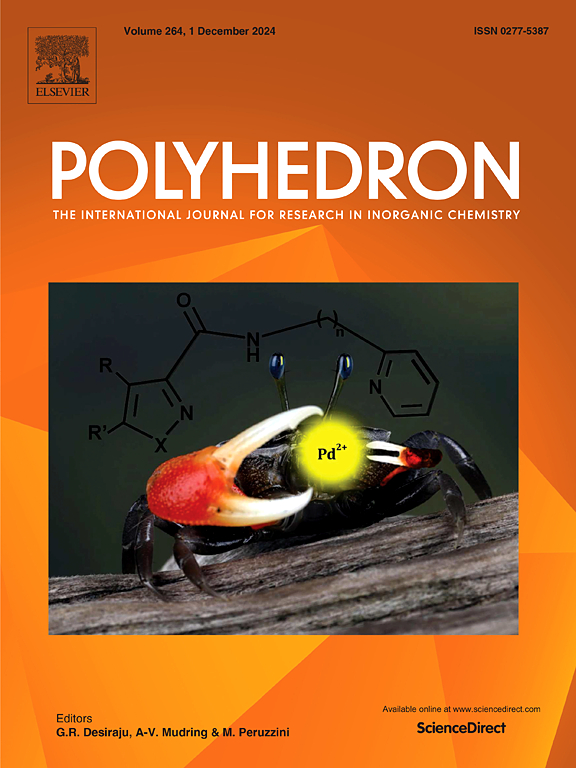Mn(III)与sal2323家族的3,5-二卤素取代配体和顺磁反离子[Co(pdms)2]2−的阳离子自旋交叉配合物
IF 2.4
3区 化学
Q2 CHEMISTRY, INORGANIC & NUCLEAR
引用次数: 0
摘要
Mn(III)与3,5-二哈尔-sal2323配体的阳离子配合物((3,5-二哈尔-sal2323 = N,N ' -双(3-(2-氧-3,5-二哈尔-苄基氨基)丙基)-乙二胺);合成了Hal = Cl/Cl, Br/Cl, Br/Br)和顺磁双电荷反离子[Co(pdms)2]2−(H2pdms = 1,2-双(甲磺酰胺)苯):{[Mn(3,5- dicl -sal2323)]2[Co(pdms)2]}·(H2O)x (1), {[Mn(3,5-Br,Cl-sal2323)]2[Co(pdms)2]}·(H2O)x(2)和{[Mn(3,5- dibr -sal2323)]2[Co(pdms)2]}·(H2O)x(3)。研究了它们的晶体结构和磁性能。这些双组分离子化合物是等结构的,在100-350 K的温度范围内表现出与阳离子子系统相关的热诱导不完全自旋跃迁,与阴离子子系统相关的强单轴磁各向异性。在零磁场和恒磁场条件下的磁化率研究表明,先前发现的含有抗磁性阳离子的[Co(pdms)2]2 -配合物的慢磁弛豫在1-3处被抑制。在结构1-3中,Co和Mn离子之间的距离缩短(6.75-6.76 Å),这可能导致自旋中心之间存在显著的偶极子-偶极子相互作用,促进与磁化量子隧穿相关的非常快速的磁弛豫。本文章由计算机程序翻译,如有差异,请以英文原文为准。
![Cation spin-crossover complexes of Mn(III) with 3,5-dihalogen-substituted ligands of the sal2323 family and the paramagnetic counterion [Co(pdms)2]2−](https://img.booksci.cn/booksciimg/2025-4/102303373441777498163.jpg)
Cation spin-crossover complexes of Mn(III) with 3,5-dihalogen-substituted ligands of the sal2323 family and the paramagnetic counterion [Co(pdms)2]2−
The cationic complexes of Mn(III) with the 3,5-diHal-sal2323 ligands ((3,5-diHal-sal2323 = N,N′-bis(3-(2-oxy-3,5-diHal-benzylideneamino)propyl)-ethylenediamine); Hal = Cl/Cl, Br/Cl, Br/Br) and a paramagnetic doubly charged counterion [Co(pdms)2]2− (H2pdms = 1,2-bis(methanesulfonamide)benzene) have been synthesized: {[Mn(3,5-diCl-sal2323)]2[Co(pdms)2]}·(H2O)x (1), {[Mn(3,5-Br,Cl-sal2323)]2[Co(pdms)2]}·(H2O)x (2), and {[Mn(3,5-diBr-sal2323)]2[Co(pdms)2]}·(H2O)x (3). Their crystal structures and magnetic properties have been studied. These two-component ionic compounds are isostructural and exhibit thermally induced incomplete spin transition in the temperature range 100–350 K associated with the cationic subsystem and a strong uniaxial magnetic anisotropy associated with the anionic subsystem. A study of ac the magnetic susceptibility in zero magnetic field and with a constant magnetic field applied has shown that the slow magnetic relaxation previously found in [Co(pdms)2]2− complexes with some diamagnetic cations is suppressed in 1–3. In structure 1–3 there are shortened distances between the Co and Mn ions (6.75–6.76 Å), which may lead to significant dipole–dipole interactions between the spin centres, promoting very fast magnetic relaxation associated with quantum tunneling of the magnetization.
求助全文
通过发布文献求助,成功后即可免费获取论文全文。
去求助
来源期刊

Polyhedron
化学-晶体学
CiteScore
4.90
自引率
7.70%
发文量
515
审稿时长
2 months
期刊介绍:
Polyhedron publishes original, fundamental, experimental and theoretical work of the highest quality in all the major areas of inorganic chemistry. This includes synthetic chemistry, coordination chemistry, organometallic chemistry, bioinorganic chemistry, and solid-state and materials chemistry.
Papers should be significant pieces of work, and all new compounds must be appropriately characterized. The inclusion of single-crystal X-ray structural data is strongly encouraged, but papers reporting only the X-ray structure determination of a single compound will usually not be considered. Papers on solid-state or materials chemistry will be expected to have a significant molecular chemistry component (such as the synthesis and characterization of the molecular precursors and/or a systematic study of the use of different precursors or reaction conditions) or demonstrate a cutting-edge application (for example inorganic materials for energy applications). Papers dealing only with stability constants are not considered.
 求助内容:
求助内容: 应助结果提醒方式:
应助结果提醒方式:


